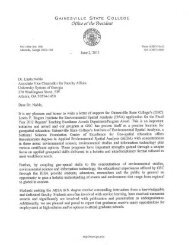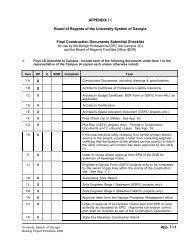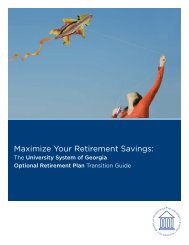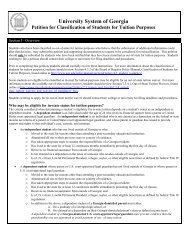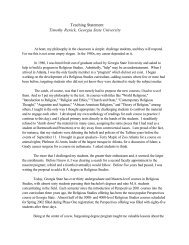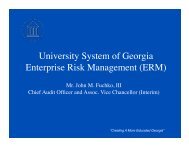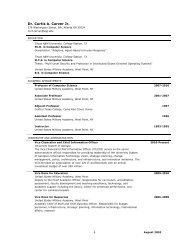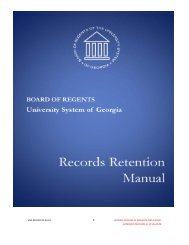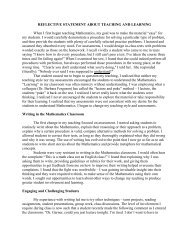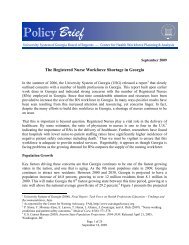66886 Federal Register / Vol. 75, No. 209 / Friday, October 29, 2010 / Rules and RegulationsWReier-Aviles on DSKGBLS3C1PROD with RULES2disbursement <strong>of</strong> aid until the studenthas successfully completed the previouspayment period. For such programs, ifan institution places the student onfinancial aid warning, the student willeither complete the program orwithdraw. If the student completes theprogram, then he or she has beensuccessful. If he or she withdraws, thenthe return <strong>of</strong> funds requirements in§ 668.22 will apply. In either case, thestudent received only those funds forwhich he or she was eligible. We do notplan to make any changes in this area.Changes: None.AppealsComment: Many commenters agreedwith allowing students who wouldotherwise lose eligibility for title IV,HEA aid to appeal the loss <strong>of</strong> eligibility.Some commenters expressed concernthat the requirements for an appeal weretoo prescriptive; for example, thecommenters noted that § 668.34(b)requires that students articulate whathad changed in their situation and thatstudents might not be able to complywith this requirement. Othercommenters stated that the <strong>Department</strong>should make the SAP appeal regulationsmore prescriptive, including byspecifying the type <strong>of</strong> documentationrequired to be submitted with an appeal.Several commenters believed that it wastoo burdensome on institutions torequire them to address student appeals,while others stated that it was tooburdensome to require institutions todevelop or evaluate academic plans forstudents who appeal.Discussion: These SAP regulations donot require that an institution accept orevaluate student appeals <strong>of</strong>determinations that the student is notmaking SAP. Moreover, the regulationsdo not require institutions to develop orprocess an academic plan for a studentwho appeals. These are merely <strong>of</strong>feredas options for institutions who wish toallow those students who are no longermeeting the SAP standards to continueto receive title IV, HEA aid. It isimportant to note that an academic planfor a student may be as complicated asa course by course plan toward degreecompletion, or as simple as amathematical calculation that specifiesthe percentage <strong>of</strong> coursework that thestudent must now complete. Academicplans need not be complicated ordetailed; the purpose <strong>of</strong> these plans ismerely to put the student on track tosuccessful program completion. Section668.34(a)(10) does require that aninstitution that does not accept appealsnotify students as to how eligibility fortitle IV, HEA aid can be regained bythose who do not meet SAP standards.An institution is free to craft a SAPpolicy that allows appeals or not, and tospecify when and how such appealswill be permitted as well as how <strong>of</strong>tenand how many times a student mayappeal. Likewise, an institution may ormay not allow an academic plan to besubmitted for a student. The SAP policy<strong>of</strong> the institution should specify theconditions under which an academicplan might be approved, or if one willbe considered at all. Becauseinstitutions have significant flexibilityin this area, the <strong>Department</strong> does notbelieve that these regulations willimpose any additional burden.Changes: None.Comment: Some commentersrequested clarification as to whenstudents on an academic plan would beevaluated. Several commentersrequested that we clarify that a studentmay submit more than one appealduring the course <strong>of</strong> his or her academiccareer. A couple <strong>of</strong> commentersinquired whether students could appealthe 150 percent completionrequirement, and exceed this maximumtimeframe if they are progressing underan approved academic plan.One commenter also asked the<strong>Department</strong> to clarify what is meant bythe requirement in § 668.34(c)(3)(iii)(B)and (d)(2)(iii)(B) that an academic planensure that the student meet the SAPstandards at a specific point in time.The commenter noted that the studentcould actually be able to graduate thefollowing term, and questioned whetheran appeal could be approved at thatpoint.Discussion: Under these regulations,the institution has the flexibility tospecify whether students on anacademic plan would have theiracademic progress evaluated at the sametime as other students, or whether theywould be subject to more frequent SAPevaluations. They should determinewhat is best for students and make theirpolicy clear in their SAP standards.As noted earlier in this preamble, aninstitution also retains flexibility underthese SAP regulations to allow multipleappeals by an individual student.Alternatively, an institution coulddecide not to allow appeals at all. Wenote, however, that because pace toprogram completion within 150 percent<strong>of</strong> the published length <strong>of</strong> theeducational program is required to beevaluated each SAP evaluation period,it would be reasonable to assume that astudent who is not meeting theinstitution’s SAP standards is not onschedule to complete the programwithin the required maximumtimeframe. Therefore, this component <strong>of</strong>the SAP standards would be subject toVerDate Mar2010 14:10 Oct 28, 2010 Jkt 223001 PO 00000 Frm 00056 Fmt 4701 Sfmt 4700 E:\FR\FM\29OCR2.SGM 29OCR2appeal, if the institution chooses topermit appeals. Finally, we expectinstitutions to assist a student whoappeals on this basis to plot a course tosuccessful completion within a newmaximum timeframe and to thenmonitor this pace toward completion.Any academic plan would need to takeinto account the student’s progression tocompletion <strong>of</strong> his or her program, whichcould, in fact, be the next term.Changes: None.Maximum TimeframeComment: Several commenters statedthat the <strong>Department</strong> should clarify the150 percent maximum timeframerequirement. One <strong>of</strong> the commentersnoted that § 668.34(b) did not definemaximum timeframe, as applied toprograms that are a combination <strong>of</strong>credit and clock hours or a combination<strong>of</strong> undergraduate and graduate work.One <strong>of</strong> the commenters argued that thefinal regulations should reinforce the150 percent maximum timeframerequirement for all programs. Anothercommenter stated that we should clarifythat the 150 percent maximumtimeframe only applies to determiningtitle IV, HEA eligibility. This commentersuggested that this maximum timeframeshould not be used for other purposes.For example, the commenter stated thatit was not appropriate for theGovernment to determine whether ornot a student should be allowed tocomplete a degree simply because titleIV, HEA eligibility had run out. Anothercommenter asked whether the 150percent maximum timeframe applied tothe student’s entire academic career oronly to the student’s current academicprogram. The commenter gave theexample <strong>of</strong> a student who had onedegree, and asked if an institutionwould include those earned creditswhen evaluating whether the studentwas progressing in his or her programwithin the maximum timeframe.Discussion: The <strong>Department</strong> believesin allowing institutions the flexibility todefine the 150 percent maximumtimeframe in the most appropriate wayfor the program in question. Inparticular, individual institutions are inthe best position to determine whethertheir combined programs, such as thosenoted by the commenters, should beevaluated as the sum <strong>of</strong> its parts (i.e.,part clock hour and part credit forexample) or as one type <strong>of</strong> programbased on the structure <strong>of</strong> the majority <strong>of</strong>the program.The 150 percent maximum timeframeonly applies to the student’s eligibilityto receive title IV, HEA aid. The<strong>Department</strong> has never regulated whetheror not a student is able to continue on
Federal Register / Vol. 75, No. 209 / Friday, October 29, 2010 / Rules and Regulations66887WReier-Aviles on DSKGBLS3C1PROD with RULES2to degree completion under aninstitution’s academic criteria. The<strong>Department</strong> also wishes to clarify thatthe 150 percent maximum timeframeapplies only to the student’s currentprogram <strong>of</strong> study. Under theseregulations, institutions retain flexibilityto define their programs <strong>of</strong> study intheir SAP policy, as well as how theywill determine how previously takencoursework applies to the student’scurrent program <strong>of</strong> study.Changes: None.NotificationComment: Several commentersrequested clarification <strong>of</strong> thenotification requirement in§ 668.34(a)(11). Specifically, thesecommenters questioned whether thisprovision would require institutions tonotify all students or only those whowere not making SAP.Discussion: Proposed § 668.34(a)(11)only requires institutions to notifystudents <strong>of</strong> the results <strong>of</strong> their SAPevaluation if the results affect thestudent’s eligibility to receive title IV,HEA aid. Institutions are not required tonotify students who are making SAP <strong>of</strong>the results <strong>of</strong> the evaluation.Changes: None.Evaluating the Validity <strong>of</strong> High SchoolDiplomas (§ 668.16(p))High School Diploma (§ 668.16(p))The <strong>Department</strong> received over 100submissions about the new high schooldiploma regulation. Most <strong>of</strong> thesesupported our proposed changes, eitherwith little or no qualification, or withsuggested modifications and concerns.Others <strong>of</strong>fered suggestions and concernswithout explicitly supporting theproposed regulation.We noted in the preamble to theNPRM that the <strong>Department</strong> intends toadd questions on the Free Applicationfor Federal Student Aid (FAFSA) askingfor the name <strong>of</strong> the high school thestudent graduated from and the Statewhere the school is located. The 2011–2012 FAFSA will have one questionwith three fields. Students who indicatethat they will have a high schooldiploma when they begin college for the2011–2012 year are instructed toprovide the name <strong>of</strong> the high schoolwhere they received or will receive thatdiploma and the city and state wherethe school is located. In the onlineapplication, FAFSA on the Web,students will not be allowed to skip thisquestion, though for 2011–2012 it willonly be presented to first-timeundergraduate students. There will be adrop-down list <strong>of</strong> both public andprivate high schools, populated by theNational Center for <strong>Education</strong> Statistics(NCES), within the <strong>Department</strong> <strong>of</strong><strong>Education</strong>, from which most studentswill be able to select the high schoolthat awarded them a diploma. Studentswho cannot find their school and thosewho complete a paper FAFSA will writein the name, city, and State <strong>of</strong> their highschool. It is important to note that theabsence <strong>of</strong> a high school on the dropdownlist does not mean that the highschool the student indicated he or shegraduated from is not legitimate. It justmeans that the school was not includedin the NCES list. Similarly, theinclusion <strong>of</strong> a high school on the dropdownlist does not necessarily meanthat the high school is legitimate.In addition to the information in thefollowing discussions, we will providemore guidance on implementing§ 668.16(p), as necessary, in DearColleague Letters, electronicannouncements, and the FederalStudent Aid Handbook.Comment: Several commentersobserved that many institutions alreadyperform some kind <strong>of</strong> high schoolevaluation as part <strong>of</strong> their admissionprocess, and one noted that because <strong>of</strong>this, it is appropriate for the <strong>Department</strong>to establish regulations requiring thevalidation <strong>of</strong> high school diplomas. Onecommenter appreciated that proposed§ 668.16(p) would help institutionswhen they are challenged by students orhigh school diploma mills for lookinginto the validity <strong>of</strong> high schooldiplomas. Another commenter notedthat a list <strong>of</strong> ‘‘good’’ high schools wouldbe valuable for students in decidingwhether they would want to obtain adiploma from a given source. Anothercommenter opined that theidentification <strong>of</strong> suspect schoolsbenefits students.Discussion: We appreciate the support<strong>of</strong> these commenters. The list <strong>of</strong> schoolsthat will appear on FAFSA on the Webis meant only as an aid for students incompleting the FAFSA. It is not a list <strong>of</strong>‘‘good’’ schools, and it may happen thatan institution will need to evaluate thediploma from one <strong>of</strong> these schools.Also, a school that does not appear onthe list should not be inferred to be‘‘bad.’’ The intent <strong>of</strong> new § 668.16(p) isto have institutions develop a processfor evaluating the legitimacy <strong>of</strong> astudent’s claim to have completed highschool and not to have simplypurchased a document that purportsthey completed a high schoolcurriculum. Under this provision,institutions must develop and followprocedures to evaluate the validity <strong>of</strong> astudent’s high school completion if theinstitution or the Secretary has reason tosuspect the legitimacy <strong>of</strong> the diploma.VerDate Mar2010 14:10 Oct 28, 2010 Jkt 223001 PO 00000 Frm 00057 Fmt 4701 Sfmt 4700 E:\FR\FM\29OCR2.SGM 29OCR2Changes: None.Comment: Many commentersrequested that the <strong>Department</strong> provideinstitutions with clear guidance on howto review the validity <strong>of</strong> high schooldiplomas and that it provide thisguidance as soon as possible. Although,as noted previously, many institutionsreview high school credentials, onelarge college noted that there are nocommon practices for these types <strong>of</strong>reviews and asked that the <strong>Department</strong>delay the effective date <strong>of</strong> thisregulatory requirement if it is unable torelease the needed guidance far enoughin advance <strong>of</strong> July 1, 2011. Thiscommenter stated that such a delaywould be needed for schools to haveenough time to create their proceduresand train their employees on followingthe procedures. One commenter askedwhat the effect <strong>of</strong> this requirementwould be on the student’s eligibility fortitle IV, HEA program assistance whenan institution is unable to determinewhether a given diploma is valid.Discussion: There is no plan to delaythe implementation <strong>of</strong> § 668.16(p). Asnoted earlier in this discussion, moreguidance will be forthcoming aboutevaluating the validity <strong>of</strong> high schooldiplomas, and many institutions havebeen evaluating the validity <strong>of</strong> highschool diplomas for years. Weencourage financial aid administrators(FAAs) to consult with each other inthis matter, which can be especiallyuseful for similar types <strong>of</strong> institutions inthe same State, where differing levels <strong>of</strong>oversight by State departments <strong>of</strong>education will have a significant effecton what procedures an institution mightestablish.With respect to the comment askingabout student eligibility for title IV,HEA program assistance when aninstitution is unable to determinewhether the student’s diploma is valid,we note that there are alternatives forthe student to establish aid eligibilityunder § 668.32(e), such as passing anATB test, or completing six credits <strong>of</strong>college coursework that apply to aprogram at the current school.Changes: None.Comment: Various commenters eitherrequested that we create a list <strong>of</strong>fraudulent or ‘‘bad’’ high schools orasked if we planned to do so. Manycommenters asked that we makeavailable both a list <strong>of</strong> ‘‘bad’’ highschools and a list <strong>of</strong> acceptable schoolsand that we update them frequently,some suggesting at least quarterly. Somecommenters requested that the effectivedate for this regulatory provision bedelayed until at least 2012–2013 so the<strong>Department</strong> can have a complete list <strong>of</strong>acceptable schools and can address
- Page 1 and 2:
Friday,October 29, 2010Part IIDepar
- Page 3 and 4:
Federal Register / Vol. 75, No. 209
- Page 6 and 7: 66836 Federal Register / Vol. 75, N
- Page 8 and 9: 66838 Federal Register / Vol. 75, N
- Page 10 and 11: WReier-Aviles on DSKGBLS3C1PROD wit
- Page 12 and 13: 66842 Federal Register / Vol. 75, N
- Page 14 and 15: 66844 Federal Register / Vol. 75, N
- Page 16 and 17: WReier-Aviles on DSKGBLS3C1PROD wit
- Page 18 and 19: 66848 Federal Register / Vol. 75, N
- Page 20 and 21: 66850 Federal Register / Vol. 75, N
- Page 22 and 23: WReier-Aviles on DSKGBLS3C1PROD wit
- Page 24 and 25: 66854 Federal Register / Vol. 75, N
- Page 26 and 27: WReier-Aviles on DSKGBLS3C1PROD wit
- Page 28 and 29: 66858 Federal Register / Vol. 75, N
- Page 30 and 31: 66860 Federal Register / Vol. 75, N
- Page 32 and 33: 66862 Federal Register / Vol. 75, N
- Page 34 and 35: 66864 Federal Register / Vol. 75, N
- Page 36 and 37: 66866 Federal Register / Vol. 75, N
- Page 38 and 39: WReier-Aviles on DSKGBLS3C1PROD wit
- Page 40 and 41: WReier-Aviles on DSKGBLS3C1PROD wit
- Page 42 and 43: 66872 Federal Register / Vol. 75, N
- Page 44 and 45: WReier-Aviles on DSKGBLS3C1PROD wit
- Page 46 and 47: WReier-Aviles on DSKGBLS3C1PROD wit
- Page 48 and 49: WReier-Aviles on DSKGBLS3C1PROD wit
- Page 50 and 51: 66880 Federal Register / Vol. 75, N
- Page 52 and 53: WReier-Aviles on DSKGBLS3C1PROD wit
- Page 54 and 55: 66884 Federal Register / Vol. 75, N
- Page 58 and 59: WReier-Aviles on DSKGBLS3C1PROD wit
- Page 60 and 61: WReier-Aviles on DSKGBLS3C1PROD wit
- Page 62 and 63: WReier-Aviles on DSKGBLS3C1PROD wit
- Page 64 and 65: WReier-Aviles on DSKGBLS3C1PROD wit
- Page 66 and 67: WReier-Aviles on DSKGBLS3C1PROD wit
- Page 68 and 69: WReier-Aviles on DSKGBLS3C1PROD wit
- Page 70 and 71: WReier-Aviles on DSKGBLS3C1PROD wit
- Page 72 and 73: 66902 Federal Register / Vol. 75, N
- Page 74 and 75: WReier-Aviles on DSKGBLS3C1PROD wit
- Page 76 and 77: WReier-Aviles on DSKGBLS3C1PROD wit
- Page 78 and 79: 66908 Federal Register / Vol. 75, N
- Page 80 and 81: WReier-Aviles on DSKGBLS3C1PROD wit
- Page 82 and 83: 66912 Federal Register / Vol. 75, N
- Page 84 and 85: WReier-Aviles on DSKGBLS3C1PROD wit
- Page 86 and 87: 66916 Federal Register / Vol. 75, N
- Page 88 and 89: WReier-Aviles on DSKGBLS3C1PROD wit
- Page 90 and 91: WReier-Aviles on DSKGBLS3C1PROD wit
- Page 92 and 93: WReier-Aviles on DSKGBLS3C1PROD wit
- Page 94 and 95: 66924 Federal Register / Vol. 75, N
- Page 96 and 97: WReier-Aviles on DSKGBLS3C1PROD wit
- Page 98 and 99: 66928 Federal Register / Vol. 75, N
- Page 100 and 101: WReier-Aviles on DSKGBLS3C1PROD wit
- Page 102 and 103: 66932 Federal Register / Vol. 75, N
- Page 104 and 105: WReier-Aviles on DSKGBLS3C1PROD wit
- Page 106 and 107:
66936 Federal Register / Vol. 75, N
- Page 108 and 109:
66938 Federal Register / Vol. 75, N
- Page 110 and 111:
66940 Federal Register / Vol. 75, N
- Page 112 and 113:
66942 Federal Register / Vol. 75, N
- Page 114 and 115:
66944 Federal Register / Vol. 75, N
- Page 116 and 117:
66946 Federal Register / Vol. 75, N
- Page 118 and 119:
WReier-Aviles on DSKGBLS3C1PROD wit
- Page 120 and 121:
WReier-Aviles on DSKGBLS3C1PROD wit
- Page 122 and 123:
WReier-Aviles on DSKGBLS3C1PROD wit
- Page 124 and 125:
66954 Federal Register / Vol. 75, N
- Page 126 and 127:
WReier-Aviles on DSKGBLS3C1PROD wit
- Page 128 and 129:
66958 Federal Register / Vol. 75, N
- Page 130 and 131:
66960 Federal Register / Vol. 75, N
- Page 132 and 133:
WReier-Aviles on DSKGBLS3C1PROD wit
- Page 134 and 135:
WReier-Aviles on DSKGBLS3C1PROD wit
- Page 136 and 137:
WReier-Aviles on DSKGBLS3C1PROD wit
- Page 138 and 139:
66968 Federal Register / Vol. 75, N
- Page 140 and 141:
66970 Federal Register / Vol. 75, N
- Page 142 and 143:
66972 Federal Register / Vol. 75, N
- Page 144 and 145:
66974 Federal Register / Vol. 75, N



